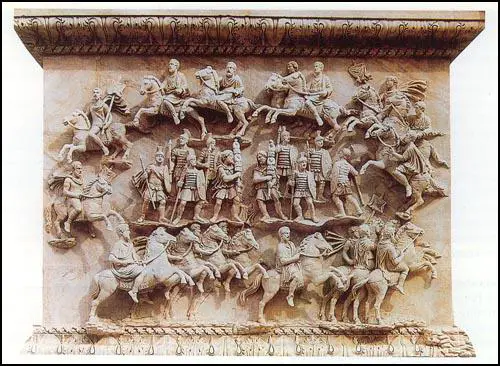The Roman Army
In the early days of Rome the army was made up of citizens who owned land. All Roman citizens between the ages of seventeen and forty-six could be called up to serve a short period in the army. This system had developed as a means of defending Roman territory from other groups in Italy. When Rome began expanding outwards, it was necessary to change the way the army was organised.
Roman landowners were no longer willing to spend long periods of time fighting a long way from home. If the empire was to survive it was necessary to have a full-time professional army. This reform was introduced by Gaius Marius in about 100 BC. Men now joined the army for fixed periods of time (16 to 20 years). Most of these men, unlike soldiers in the previous Roman army, were landless citizens.
Gaius Marius also introduced other reforms. To ensure his soldiers were fit he ordered them to go on long route-marches. While doing this they had to carry their own cooking utensils, three days' food rations, a sickle, rope, pick-axe, turf-cutter, shield, sword and javelin. Not surprisingly, Roman legionnaires obtained the nick-name "Marius' mules".
The Roman army was organised into legions. Each legion was commanded by a senator who was called a legatus. He ruled the legion with the help of six military tribunes. These men were young aristocrats who served in the army until they were about twenty-five years old.
Each legion was made up of 6,000 men. Of these, only 5,300 would have been fighting men. The rest were dispatch riders, clerks, master builders, surveyors, water engineers, musicians, blacksmiths, surgeons, and weapon makers.

Roman soldiers were organised into units of eight men called contubernia. They would share a tent on the march or a room in the barracks. When on the move, the tent, made of leather, would be carried by the contubernia's mule. The mule would also carry a pair of mill-stones for grinding the group's corn.
Ten contubernia made up a century. Originally the century had been a hundred men but by the time of the Roman Empire it had been reduced to eighty. Each century was commanded by a centurion. Unlike the legatus and the six tribunes who were members of the aristocracy, the centurion was usually a professional soldier who had been promoted for the abilities he had shown on the battlefield.
Emperor Augustus introduced the idea of using auxiliaries in the Roman army. He relied on the specialised talents of different groups. For example, Syrians were used as archers, Thracians as cavalry spearmen and Moors as desert soldiers. Auxiliaries were paid less than legionnaires, but one of the main attractions was that they became Roman citizens when they finished their term in the army.
Soldiers who acted bravely during battle would be rewarded. Ordinary soldiers received bracelets, neck chains or metal discs, while officers received crowns, spears and flags. The most valued honour was to receive the corona civica. This medal was only awarded to Romans whose bravery had saved the life of a fellow soldier. Another medal, the corona muralis, was given to the soldier who during an attack was the first person to climb over the enemy's defence wall.
Most soldiers were employed defending the frontiers of the Roman Empire. A system of watch-towers was built on high parts of the frontier. Attached to these would be signal-towers. Here men used torches to communicate information in code to Roman commanders some distance away.
For long periods of time during the empire the Romans were not involved in wars. Some soldiers would go through twenty years of service without seeing action. When they were not fighting, soldiers spent their time building roads, forts and canals. They were also used to guard slaves working in the state-owned mines.
Primary Sources
(1) Dionysius of Halicamassus, Roman Antiquities (c. 30 BC)
We now have better arms than the barbarians. We have breastplates, greaves, mighty shields, with which we keep our entire bodies protected, two-edged swords, and instead of the spear the javelin, a missile that cannot be dodged.
(2) Polybius, The Rise of the Roman Empire (c. 110 BC)
If the Roman soldier is found guilty (of falling asleep on duty), he is punished by fustuarium. This is carried out as follows. The tribune takes a cudgel and lightly touches the condemned man with it, whereupon all the soldiers fall upon him with clubs and stones, and usually kill him... If large groups desert their posts under extreme pressure, the officers reject the idea of beating to death or executing all who are guilty, but the solution they adopt is as effective as it is terrifying. The tribune calls the legion on parade... he chooses by lot... about a tenth of those who have shown themselves guilty of cowardice. Those on whom the lot has fallen are clubbed to death.
Questions
1. List the major changes that took place in the Roman army. Write them down in the order they took place. Explain the major reason why these changes happened.
2. Study source 1. Select examples from the passage where the author expresses (i) a fact, and (ii) an opinion.
3. Explain the different reasons why Roman soldiers were willing to fight bravely in battle. You will need to consult both the main text and the sources before answering this question.
4. Some Roman commanders were concerned about these changes in the Roman army. Can you explain why?
